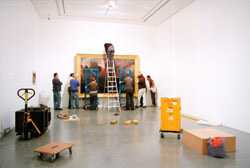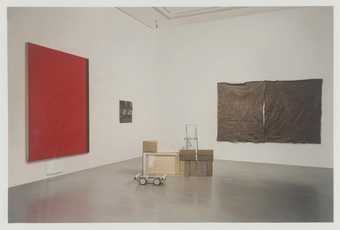Andrew Grassie is a painter whose works engage with complex ideas. Grassieãs starting point is a re-examination of the fundamental question of what to paint. He turns this question on its head, producing paintings which present a series of compelling propositions about painting itself, recording and representing scenarios such as the circumstances of their own production orô display.
New Hang consists of thirteen small paintings. Each shows a different view of an exhibition in the space in which Grassieãs paintings are exhibited, Tate Britainãs Art Now room. This exhibition is made up of works from the Tate collection, including well-known paintings and sculptures by historic British artists such as George Stubbs and J.M.W. Turner, international modern ãmastersã such as Barnett Newman and Pablo Picasso, and works by two living artists: Bridget Riley and Bruce Nauman. Grassieãs paintings are hung according to the view of the room that they depict. Thus, a viewer looking at one of Grassieãs pictures will see a view of the space in which they are standing. They might also notice that the lighting in the room is exactly the same as in Grassieãs paintings. This doubling ã of the space in the paintings and the space which the viewer occupies ã creates a dislocation which questions our sense of reality, space andô illusion.
To make New Hang Grassie selected, at intervals, works from ¯íý¿°ìÝÞãs collection and installed them in the Art Now room between exhibitions. Having mapped out the space and established his viewpoints (and thus camera positions), Grassie photographed the same set of views each time a new group of works was installed. He then pieced together a set of images of the ãcompleteã exhibition; an impossible or, more accurately, implausible event. Then, working from these images, he painted the pictures that make up the currentô exhibition.
The title refers to the annual redisplay of the collection that used to take place at the Tate Gallery. The annual New Hang was an opportunity to see works in fresh curatorial contexts. Grassieãs project offers a ãvirtualã equivalent of such a re-display, as well as challenging its methodology. Viewers might question Grassieãs choice of works, how they are displayed, and what readings and meanings emerge from the combinations he has pictured. In fact his choices were dictated by the desire to work with certain favourite artists and works, as well as the formal demands of his compositions. He has stressed that there is no curatorial intention in his selection or his ãhangã. Nonetheless, certain themes do emerge: contrasting depictions of the body in works by William Blake, Henry Moore, Hans Bellmer and Picasso, or the doubling seen in both Naumanãs Double No and The Cholmondeley Ladies. Free from the burden of a curatorial agenda, Grassie enjoys ãaccidentalã conjunctions such as the way Frederic Leightonãs Sluggard seems to be ÿ˜aunting himself to Picassoãs Nude Woman in a Red Armchair. He is also interested in the way these works of art that use such radically different languages of representation have been brought together in his paintings, which themselves use yet another form of pictorialô language.
Grassieãs way of working developed out of an impasse he found himself in while studying at the Royal College of Art. Under pressure to develop a ãsignatureã style, Grassie worked his way through many stylistic models, eventually reaching what he felt was a dead end. His response to this was to start painting copies of his own work: a solution reminiscent of Samuel Beckettãs resignation, ãI canãt go on. Iãll go on.ã Yet Grassie also found that in making what at ÿ˜rst seemed like a kind of ãdumbã gesture ã a wilfully negationist action in that it seemed to deny creativity - something new and interesting emerged. Grassie explained: ãMy self-reÿ˜exive stance originated from the problem of what to paint, or rather how to justify it to myself. The technique of copying a photograph, rather than implying an interest in the ãphoto-realã, was simply a paring down to the bare bone of a practice. What emerged out of this discipline was surprisingly expansive and referential.ã One might say that because of his doubt about the practice of painting, Grassieãs work has developed as a way of providing him with excuses to makeô paintings.
Grassieãs methods are relatively simple, if technically demanding, but from them emerges a complex and layered situation that can be misunderstood as a form of photo-realism or appropriation. However, he has said: ãI am as much interested in the differences that occur in the ãlookã of my paintings from the photographs, and what this implies, than any proximity. They seem now to refer to the ãsilent gazeã of much seventeenth-century Dutch art and to certain forms of minimalism more than to photo-realism.ã As this suggests, Grassie is engaged in a dialogue with art history. As well as methodologies of creation, exhibition and display, his work addresses a strand that runs throughout art history, of artists drawing on the work of their predecessors for inspiration. A parallel strand locates copying (initially as a means of instruction) as fertile ground. Work such as New Hang is not appropriation however, for the works of art he depicts are identiÿ˜ed as real works within a real space and retain their originalô identity.
Grassieãs practice suggests that we might consider his work in two further ways: as conceptual art, and as installation art. Sol Le Witt argued that the use of conceptual frameworks and self-imposed conditions ãeliminates the arbitrary, the capricious and the subjective as much as possibleã. But Grassie has found that ãfreedom from having to inventã actually means he can locate self-expression in other aspects of his work, in painterly qualities such as ãtouchã forô example.
New Hang consists of thirteen paintings, which will almost certainly be dispersed after the show. But in its complete form it exists as a single piece which occupies (and activates) the space in which it is displayed. It is a site-speciÿ˜c work, made for the Art Now room. As such it is essentially an installation in which the component parts happen to beô paintings.
Text by Benô Tufnell


